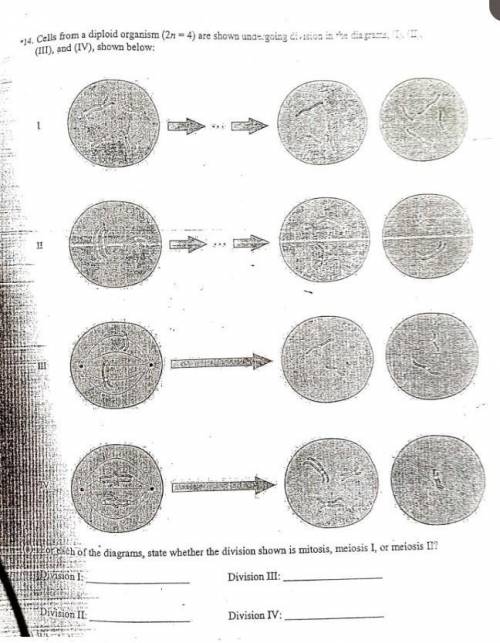
Biology, 10.03.2021 18:30 macymichtavy
Cells from a diploid organism (2n=4) are shown undergoing division in the diagrams, (I), (II), (III), and (IV), shown above.
a) For each of the diagrams, state whether the division shown is mitosis, meiosis I, or meiosis II?
i) Division I
ii) Division II
iii) Division III
iv) Division IV
b) Which diagramS show synapsed chromosomes?
c) Which of the above diagrams starts with a haploid cell?
d) In which diagram did segregation of both chromosome pairs occur?
e) What is the term that best describes the phenomenon that occured in the division of diagram IV?
I need help with this URGENTLY, PLEASE! It's not compulsory for one person to answer all the questions. But if you know the answers to all, kindly share please, please. Explanation will be highly appreciated. THANK YOU!!!


Answers: 3


Another question on Biology

Biology, 21.06.2019 14:00
The seaport that is near caracas has which type of climate?
Answers: 1

Biology, 22.06.2019 00:30
Experiments in environmental toxicology can sometimes be manipulative experiments in which the researcher actively chooses and manipulates the independent variable. in hunt's study, for example, dosages of bpa were manipulated and the effects were measured. in manipulative studies, the researcher controls all the other variables in the experiment, so any health effects observed in the test subjects can be attributed to differences in the independent variable. in other cases, researchers use natural experiments in which the dependent variable (typically a measure of organism health) is measured under differing contexts that are not manipulated. say, for example, that an accidental chemical spill contaminates five ponds. to determine the possible effects of the toxic chemical on frogs, a researcher could compare the hatching rate of frog eggs laid in those five ponds to the hatching rate of eggs laid in five uncontaminated ponds nearby. this would be an example of a natural experiment because concentrations of the toxic chemical in the ponds were not controlled by the experimenter, but rather resulted from the chemical spill. drag type of experiment on the left to the example of experiment on the right. blood concentrations of bpa in college students are compared to their recent manipulative consumption of canned food items 2. the feeding behavior of fish in streams that receive acidic runoff from strip mines is compared to the feeding behavior of fish in unaffected streams. the deformity rate in baby birds from nests in pesticide-sprayed fields is compared to the deformity rate in birds from nests in unsprayed fields 4 tumor development is compared in mice exposed to five dosages of a known carcinogen in the laboratory foraging activity levels are compared in tadpoles exposed to four concentrations of toxic metals in the laboratory. growth of corn plants is compared in field plots sprayed with three different dosage: s of weed killer 7 bpa concentrations in the urine of people with diabetes are compared to bpa concentrations in the urine of people without diabetes - natural; manipulative
Answers: 1


Biology, 22.06.2019 11:30
Which organism can most likely be classifild as domain bateria
Answers: 1
You know the right answer?
Cells from a diploid organism (2n=4) are shown undergoing division in the diagrams, (I), (II), (III)...
Questions


Mathematics, 23.08.2019 17:00


History, 23.08.2019 17:00

Mathematics, 23.08.2019 17:00








History, 23.08.2019 17:00


Chemistry, 23.08.2019 17:00

History, 23.08.2019 17:00




Mathematics, 23.08.2019 17:00



